Review: Dishonored
 Monday, October 15, 2012 at 10:00AM
Monday, October 15, 2012 at 10:00AM 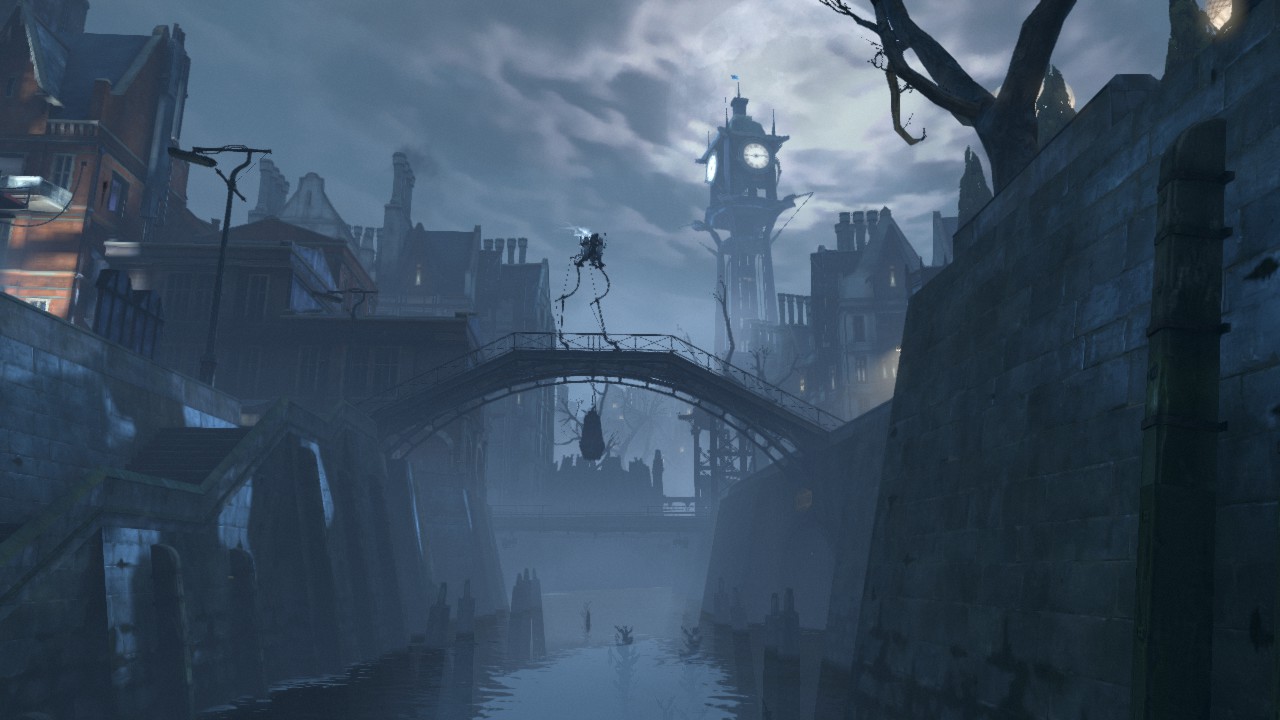 There’s something very wrong with the gaming industry today. While this generation has brought a surprising amount of new concepts, technology and manes by which to elaborate on a gameplay experience, there have been far more detriments paid to the consumer. Homogenization has entered our industry and, like some sort of plague, it has swept throughout the publishing and development scenes. This focus has infected far too many talented teams by forcing them to focus on the largest common denominator and virulently making it impossible for great ideas to get off the ground. For some reason, major developers and publishers believe that if it doesn’t look, walk and talk like the biggest selling franchises out there that it simply won’t sell. This couldn’t be farther from the truth.
There’s something very wrong with the gaming industry today. While this generation has brought a surprising amount of new concepts, technology and manes by which to elaborate on a gameplay experience, there have been far more detriments paid to the consumer. Homogenization has entered our industry and, like some sort of plague, it has swept throughout the publishing and development scenes. This focus has infected far too many talented teams by forcing them to focus on the largest common denominator and virulently making it impossible for great ideas to get off the ground. For some reason, major developers and publishers believe that if it doesn’t look, walk and talk like the biggest selling franchises out there that it simply won’t sell. This couldn’t be farther from the truth.
Triple-A Stealth games have been one of the more damaged victims of this shift toward what could arguably be called ‘Call of Dutyism.’ Staple franchises like Splinter Cell, once a slow paced, thoughtful series about knowing just when and how combat should be pursued, have become action-filled murderfests. Newer series like Assassin’s Creed and last year’s Deus Ex Human Revolution dabble in stealth but no new intellectual property this generation has really been all about flight rather than fight. Dishonored, the new IP from Arkane Studios, looks to bunk this trend.
Click to read the full article Hooked Gamers,
Hooked Gamers,  Review,
Review,  Xbox 360
Xbox 360 Review: Resident Evil 6
 Sunday, October 7, 2012 at 12:00PM
Sunday, October 7, 2012 at 12:00PM 
I find it a bit difficult to believe that, fifteen years ago, Capcom released the first Resident Evil game. I was just entering puberty when the M-rated horror title hit the Sony Playstation and, when I finally got my hands on it a couple years post-launch it damn near terrified me. To this day I cannot go back to the original, Playstation version of the first game as it scared me quite a bit more than my 13 year old mind could accept, not to mention my 27 year old self today. After getting over most of my fears with Resident Evil 2 I quickly embraced the series, enjoying every core title in the series and looking forward to the next entry that was just around the corner.
Fifteen years on however, many things have changed. Gone are the design paradigms Shinji Mikami originally set out with strict camera angles, open world gameplay, ammunition scarcity and so much more that made every Resident Evil title from 1996 to 2002. In their stead we have third-person, player-controlled cameras, linear gameplay design and more than enough ammo to take out the dozen or so enemies that you encounter in every area you visit. Resident Evil may have begun as a series designed to keep the player on the edge of their seat, waiting for the next big scare but with the arrival of Resident Evil 4 the saga completely changed, focusing on cinematic action and weapon-wielding, intelligent human enemies.
The second core title in the series to be released since Shinji Mikami’s departure in 2006, Resident Evil 6 marks the last Resident Evil of this console generation. With the design lessons learned from entries four and five, can this sixth installment continue the tradition of exceptionalism we’ve come to expect from this decade and a half old series?
Click to read the full article
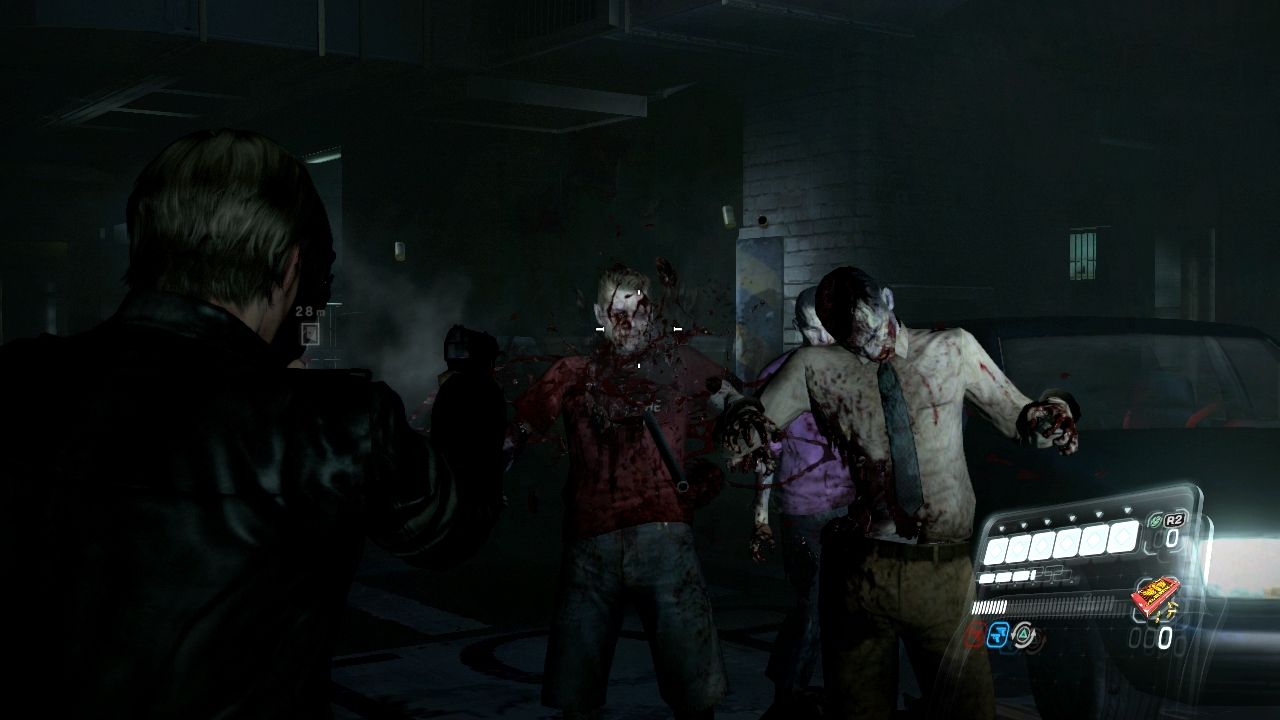
A Resurrection of Evil
Three years after a superhuman Albert Wesker was stopped from transforming our world into a planet of Uroboros-mutated monsters, the threat of bioterrorism has reached near pandemic levels. A new infection, known as the C-Virus, has become weaponized and is being used in major military conflicts such as Edonia, an Eastern European nation in the middle of a civil war and the site of where Resident Evil 6 begins. Composed of four separate campaigns (the fourth is unlocked after completing the first three), Resident Evil 6 follows two heroes per campaign each with separate paths and endings for each set of heroes, albeit with intersections between them all at different points throughout the story.
Chronologically, our story begins on Christmas Eve, 2012, with a new character: Jake Muller, a mercenary whose platoon has been hired by the local Edonian rebels. Muller’s platoon is equipped with stimulant injectors which turn out to actually be C-Virus containers, turning them into J’avo (pronounced jue-wha-voe, a Serbo-Croation word meaning ‘devil’), soldiers with mutation abilities similar to the victims of Las Palagas and Uroboros. Muller is forced to fight off his fellow soldiers after his injection doesn’t work on him and, shortly thereafter, encounters United States DSO agent Sherry Birkin. Birkin, the grown-up daughter of G-Virus creator Dr. William Birkin, reveals that Muller’s own antibodies are impervious to the effects of the C-Virus and could be a cure for the new pathogen. Jake, being a mercenary, offers his blood up provided he is compensated handsomely. Of note you will find that this campaign is a bit reminiscent of Resident Evil 3 as the pair are continuously stalked by an enemy called the Ustanak, a towering foe not unlike a cross between an El Gigante and Nemesis on steroids.
Chris Redfield’s campaign begins six months later in June of 2013 in Lanshiang, China. Brought out of retirement by BSAA member and former subordinate Piers Nivans (owner of the single most ridiculous name this year), Chris and crew are charged with countering a J’avo terrorist attack that is gripping the city. There’s more to this threat than just a J’avo incursion however as Chris and Piers find out early on. This campaign plays out quite like Resident Evil 5, heavy on the action and frequent player-on-player support sequences.
Leon Kennedy and new protagonist Helena Harper’s story begins a day before Redfield’s, in the American city of Tall Oaks. A sudden outbreak of the C-Virus outbreak occurs during US President Benford’s speech he had planned to bring to light the events that took place during the Raccoon City incident and the subsequent death of the Umbrella Corporation. With the President dead and Helena hiding secrets from Leon about the cause of the outbreak, the two must struggle to survive the outbreak that has engulfed the city, a stark reflection of what he experienced fifteen years before. This campaign plays tribute to Resident Evil 4 and, of the three main campaigns, leans the most toward a core RE experience.
One final campaign is made available after having completed and since it’s already been widely reported as to what it is I’ll just come out and say it. Staring elusive mystery woman Ada Wong, everyone’s favorite red dress-wearing protagonist(?) gets her own campaign that, unlike the others, does not come with a partner and is therefore a singleplayer only experience. Ada’s campaign serves as a kind of ‘best of’ experience, exploring levels and areas previously seen in the other three stories albeit from a different perspective.
As stated before, each campaign occurs mostly in parallel to one another with several intersecting points between each one, though all three never come together at any one time. Each consists of five chapters measuring between an hour or two to complete. I can confirm that the overall length of the game takes at least 18-20 hours to complete so it is fairly lengthy, especially for a title like this these days.
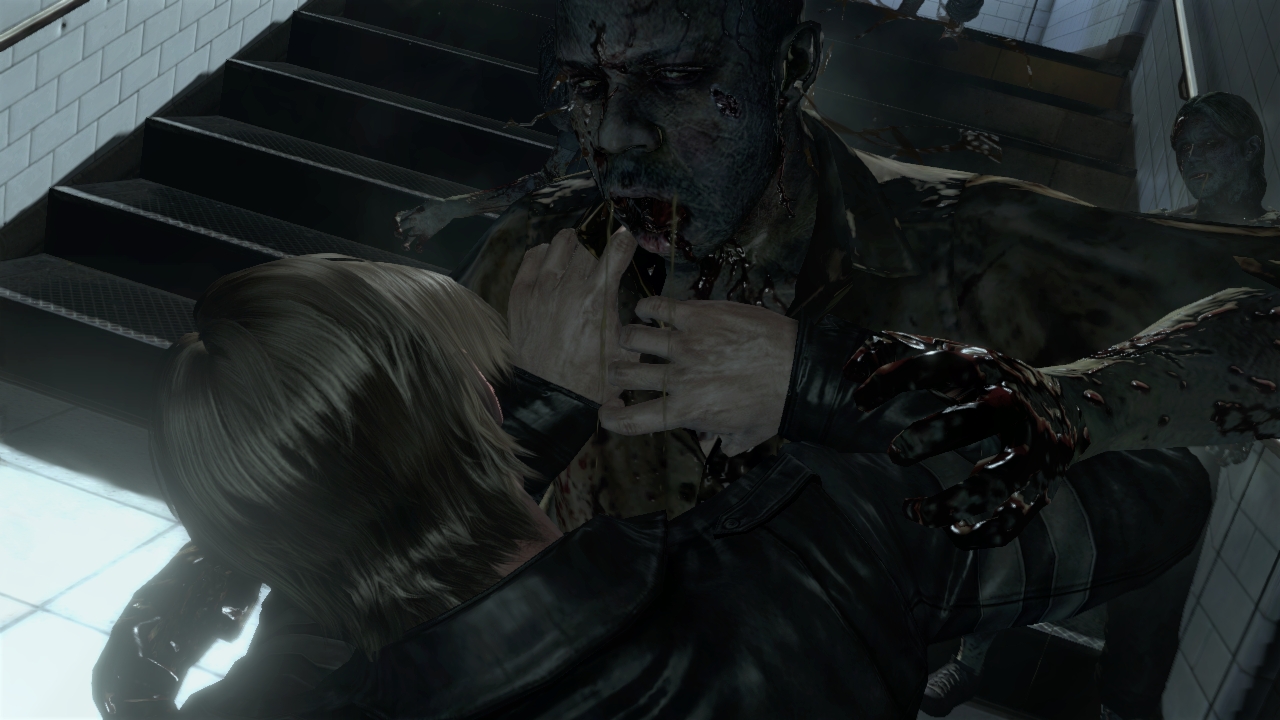
The problems with Resident Evil 6’s story don’t necessarily pertain to its length however. More so, it seems that it is the way the story is presented. Each campaign is completely separate with their own endings so you never tradeoff between the three sets of heroes. Because of this you don’t really get a sense for the overall story until you begin in on Ada’s story. Ada’s experience wraps everything together but, after being provided with three separate stories with their own endings and little closure between them, looking back I can’t help but feel that we are told far too little in the Leon, Chris and Jake’s stories.
This is made even duller by just how little story is presented to us. Each campaign begins in medias res, giving next to nothing in background as to your current situation and what has been leading up to it. Capcom somewhere along the line also decided to get rid of one of the series’ staple features: books, journals and notes that can be found littered around the environment. These really added to the overall world of the previous seven games, giving depth to events and establishing an emotional tone for just what is going on. Even beyond the confines of the story they were at the heart of many of the puzzles in the game and gave context to characters and bosses. Without these you are left with an environment in which the player is forced to just go with the flow, missing one of the primary driving forces that get a player to go from point A to point B. These items, though small, add to the overall scope of a good story and their disappointing removal from Resident Evil 6 not only harms the overall narrative but it also sets forth a terrible precedent for what will follow with the next eventual sequel. People don’t just come to Resident Evil for the gameplay, Capcom, they also care about the universe it is set in.
As it stands, the structure of the three campaign system is an overall disappointing experience. Had they been told chronologically or perhaps jumped from one perspective to another Resident Evil 6’s story could have been far more discernible, if not entertaining. In its current state though the story just isn’t satisfying.
A New Horrorless Paradigm
Resident Evil has changed dramatically over the past decade and a half but while the stories have remained a strong, interesting narrative (until this title), what has shifted dramatically is the variety of gameplay to be found across all the titles. For the core, numerated titles of the series, Capcom chose with Resident Evil 4 to go with a behind the shoulder, third-person view with tight controls that were quite reminiscent of the tank controls that were typical of the first five titles in the series. Resident Evil 6, takes this trend to its logical inclusion. This reviewer believes it is more than fair to announce that, with the arrival of this title (should this be indicative of the core experience going forward) that Resident Evil is now a third-person shooter. Yuck.
The shift toward a third-person shooter is made quite clear thanks to Capcom’s changing of the control scheme. The camera, for example, is now unlocked and allows the player to pan it around their character in almost any direction (save for directly up). Players can now run by default instead of having to hold a button down which now substitutes as a sprint feature. Players can now switch over-the-shoulder perspectives to get a better view of what they are looking at. Even the movement has changed, allowing you to move a bit more freely in the direction you want to though not nearly free enough to justify the transition. To explain, allow me to offer this example: it took me ten seconds to proper align my character to open a box in a room. This new movement scheme, at times, can be quite annoying.
The transition from survival horror to survival action in the form of a third-person shooter could not have been made more certain than when you take a look at the combat and the pacing thereof. Thanks to the new movement controls players can now run, sprint and even dive and roll to avoid attacking enemies. A new quickshot option has been made available so you don’t have to even aim in order to fire off a bullet. Several weapons in the game now feature alternate fire modes such as a grenade launcher on your assault rifle or even multiple firing rates for a pistol. Players can now move while shooting, an item many have asked for since Resident Evil 4. Melee combat has been introduced alongside a stamina bar which the player can utilize to do combination attacks that previously required precise timing and were massively effective when done properly. These features certainly lend credit toward being a shooter-oriented title but this is only the tip of the iceberg.
Beneath the water’s edge of this potential ship wreaker is a plethora of different gameplay design compromises and regrettable choices and the game’s pacing is right at the top of this list. Unlike the seven previous entries in the series, Resident Evil 6 allows almost next to no time to calm moments between encounters with enemies. Previously, calm moments allowed for both the player to prepare for the next area while building tension for what’s just around the corner. This new entry throws these moments out the window as, save for a few key moments during Leon and Ada’s campaigns, you never are allowed to rest. The game even forces you forward at times, continuously respawning enemies until you either retreat or are killed.
Another big sign of an ill-advised shift in gameplay design: a full cover system. Yes, you read that right, Resident Evil 6 has taken notes from what was accomplished in the two previous titles and added a full cover system to the series. Utilizing a hold-to-cover system like what was introduced in Rainbow Six: Vegas, the game allows you to stick to corners for cover by holding down the left trigger. When at a piece of waist-high cover however you have to aim and press another button in order to hide behind it. It’s unfortunate however that the cover system is quite broken. More often than not strafe shooting near a corner will result in you sticking to it rather than actually allowing you to continue on. The game also has trouble at times figuring out whether you want to crouch behind something or whether you want to vault right over it. Even when firing from cover your angle of attack is very limited and, quite often, your character will block your view. Many times throughout the game this reviewer ended up getting hurt or dying as a result of the cover system being way too sticky for what it should be. It just doesn’t work when and how it should and, given that cover systems have been one of the biggest and most widely used innovations of this generation, it’s inexcusable.
The cover system could have been tolerated had your partner AI been worth it. As it turns out, despite words coming out of their mouths and being able to aim and shoot, your teammates are about as smart as an expired turnip. They can be relied upon to aim and fire at what’s in front of them but anything other than that is simply false hope. Even when teamed up with multiple friendly AIs I found myself being shot at quite often by a J’avo that all my allies decided to rush past and completely ignore, forcing me to dispose of it in order to move on. Quite a few times this reviewer was abandoned to die by my teammate AI as it felt that it was time to move on to a new area. The only saving grace to be had is that they are both damn near indestructible and do have unlimited ammo. That’s it, nothing more.
It seems that almost every aspect of the two previous Resident Evil titles has either gone through a makeover or been redacted entirely in this entry. Gone is any sense of proper inventory management within or outside of gameplay. The economy system has been completely removed and replaced with a create-a-class skill-based one, making the player spend earned skill points found throughout the game on character upgrades that don’t seem noticeable most of the time. Resident Evil 6 even features a segmented regenerative health system, a series first and a detriment to any attempt at retaining a sense of horror.
Capcom, what were you thinking? And, for that matter, what were you on while making this? Whatever it was, it couldn’t have been legal.
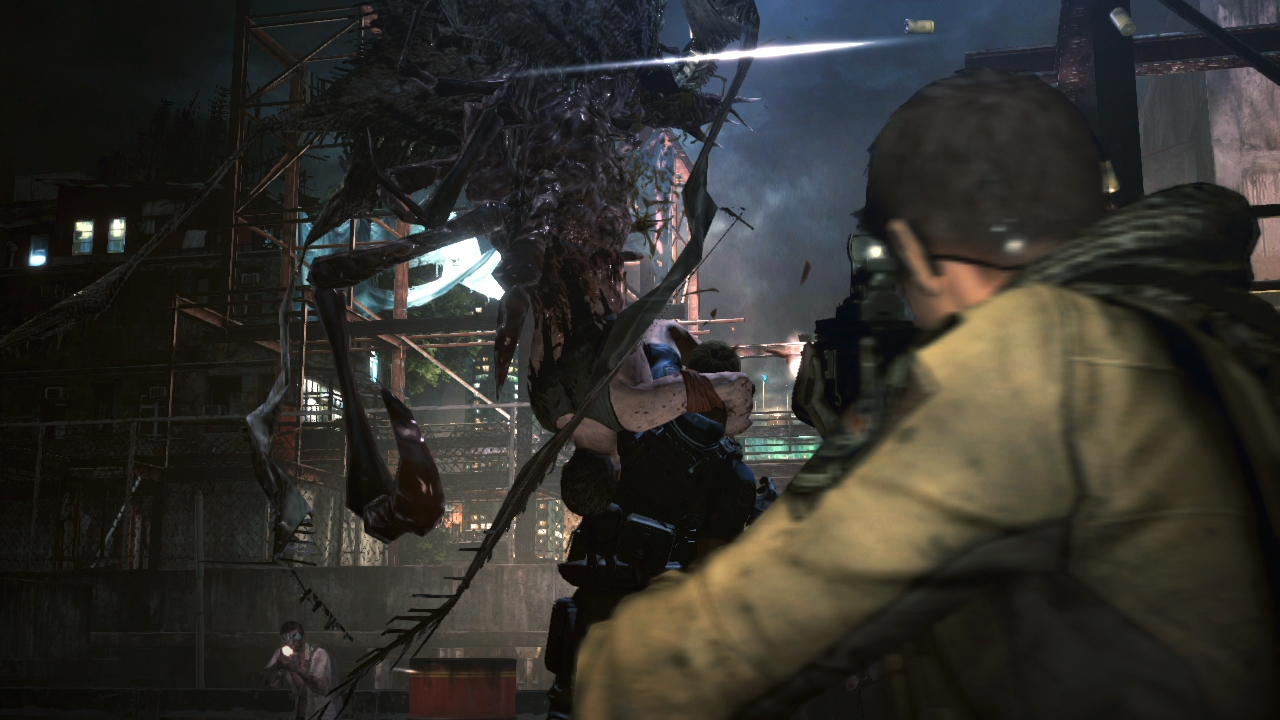
Abandoning a Heritage
As I stated before, Resident Evil 6 now plays like a third-person shooter. That being said and despite all the changes to the basic gameplay design that made the fourth and fifth numbered titles so good, does this sixth title still have what it takes to be strong? This reviewer is running out of page space but I will address some of the most important features.
Open world gameplay was always a strong aspect of a Resident Evil title. Despite being a refinement of what made Shinji Mikami’s departing title so strong, Chris Redfield and Sheva Alomar’s adventure in Africa retained many open areas to explore and find things. This new title all but abandons any notion of backtracking or open exploration. Save for a few particular areas in Jake and Chris’ campaigns the core experience of Resident Evil 6 is a linear corridor crawler that leaves no room for exploration. Strike one.
A feeling of unease has always been a staple of the series and this has been disregarded as well with this new title. Throughout the course of the game you never have to fear of sudden enemy attacks as only the most dangerous encounters are prefaced by a bounty of ammunition and health items. Beyond that, you always have a sense of control thanks to enemies dropping more than enough ammunition to get the job done, making only moments where the game directs you to flee ones where you are not the master of the room. There was not a single encounter in Resident Evil 6 in which this reviewer felt that a situation could not be handled. Capcom seems to have lost sight of this crucial aspect. Strike two.
These two primary facets have always tied into what was the most important one of them all: the horror factor. Resident Evil 6, despite all appearances however, isn’t a horror game. In fact, the final version is far from it. Instead the game is focused more on gore porn, trying to gross out the player more than actually present genuine scares. It seems that Capcom is trying to scare the player by producing gross looking enemies and, because they are ugly to look at, Capcom seems to think that you should be afraid of them. No, Capcom, we are not afraid of them. Thanks to almost every gameplay aspect listed above you can be absolutely certain that I am not afraid to take on an Ustanak or any other enemy in the game. Regenerative health, plenty of ammo, and AI can focus squarely on a boss without the fear of dying? There’s nothing to be afraid of here, Capcom, nothing at all. Strike three, you’re out.
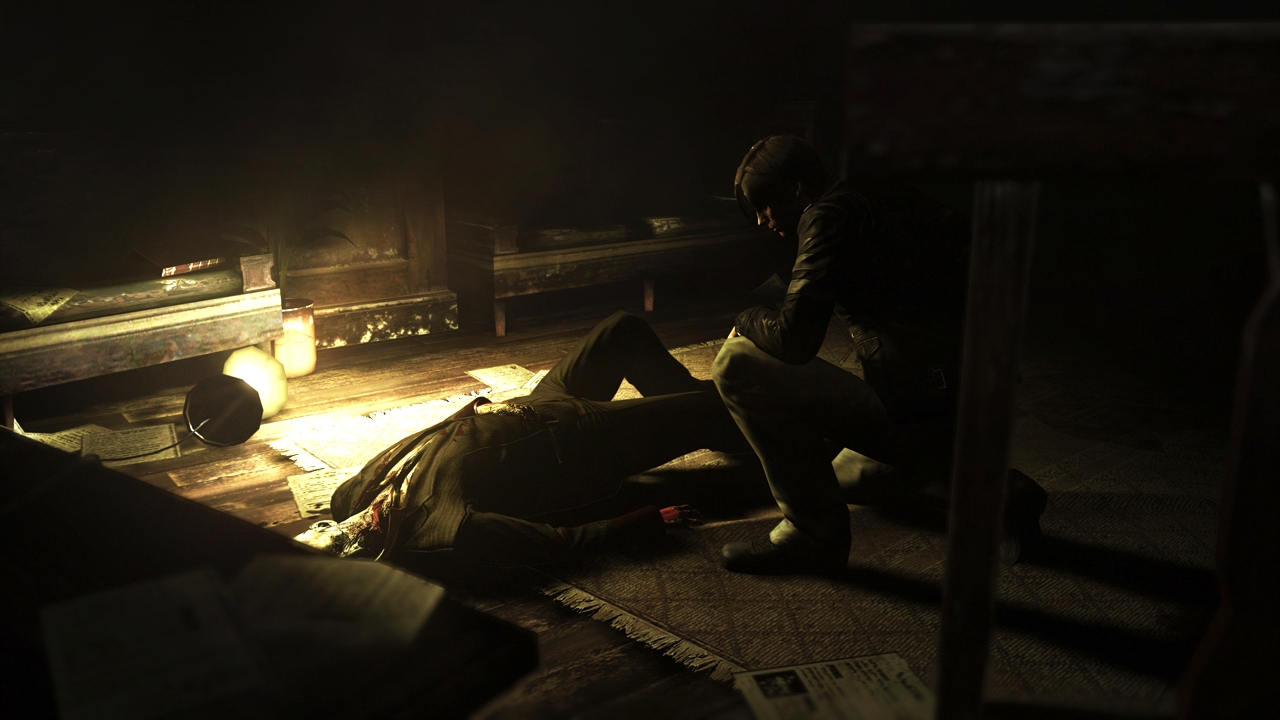
The Dethroned King
For fifteen years Resident Evil has been the name mentioned when talking about the survival horror genre. As of October 2nd, 2012 that magnanimous title no longer applies to this once hallowed title. Somewhere along the line this project took a turn and went in the wrong direction, one similar to the one that drove this year’s disastrously bad Operation Raccoon City off a cliff. Not only is Resident Evil 6 not a worthy successor to the name that made us cringe in fear over the past decade and a half, it can only be called a Resident Evil game in name and story, less so in the latter.
This is certainly not what anybody wanted and it shouldn’t be regarded as something Capcom should be proud of. At best Resident Evil 6 is a mediocre third person shooter with zombies and plenty of unnecessary rail sequences. At worst, it is a detriment to the entire horror genre.
If this is what we will be seeing going forward for the series then this reviewer does not look forward to what will arrive in Resident Evil 7. Capcom, it’s time to seriously rethink this series. Reboot it, completely rework it or simply move on. If this is the future of Resident Evil then it’d be much better to put the series down than to let it limp on for another few years.
Review: Spec Ops The Line
 Friday, July 27, 2012 at 12:05PM
Friday, July 27, 2012 at 12:05PM 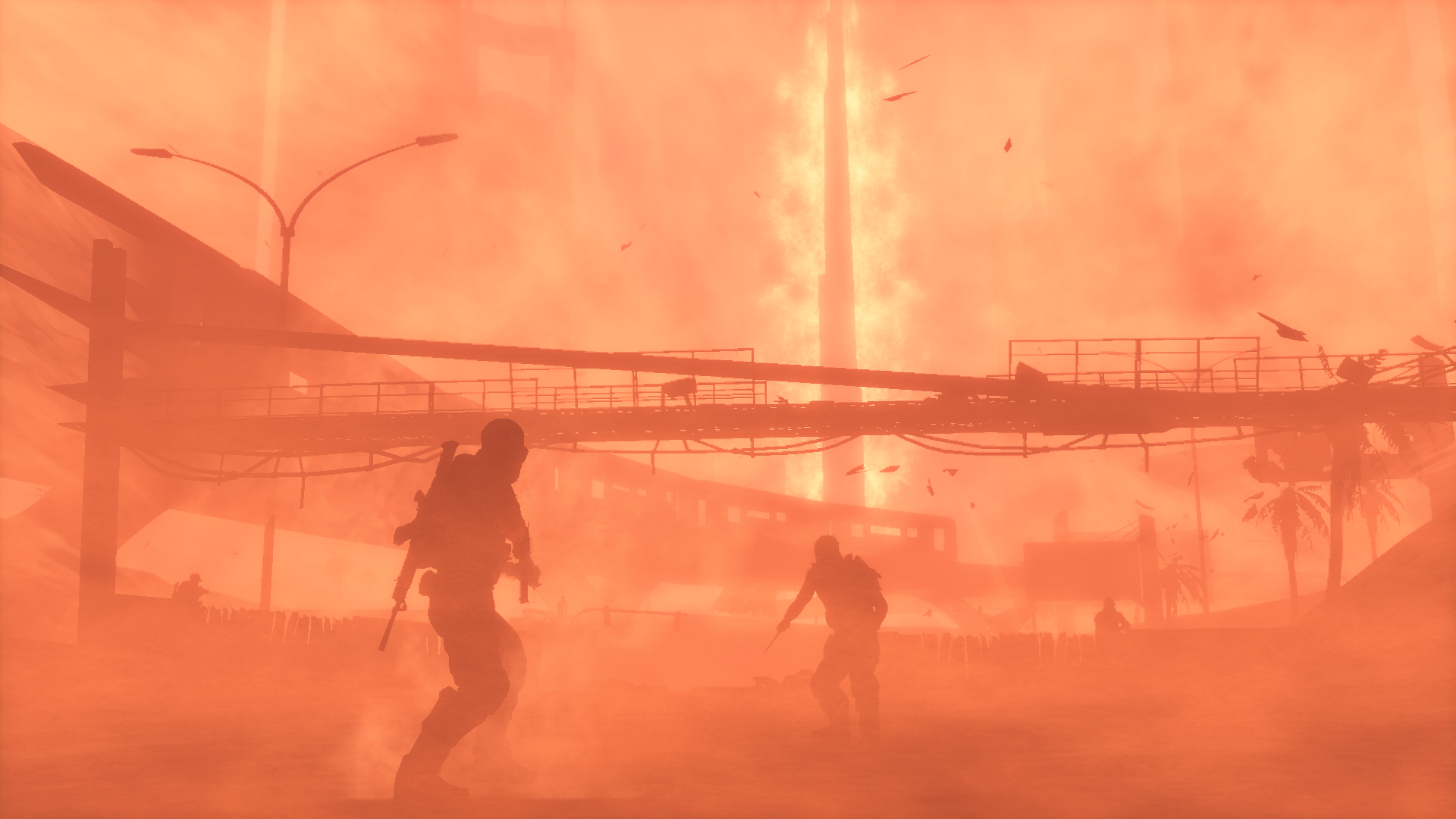
When it comes to the shooter genre, few mechanics have changed since the early days of Doom and the like. You have an objective to complete, there are a bunch of angry dudes in your way and you have to kill them all in order to advance in the game. Regardless of linearity, artificial intelligence or several dozen innovations increasingly improved over the past two decades, the approach to a game’s story hasn’t really lent itself to being truly exceptional. Every few years we get a Half-Life 2 or a Bioshock that really engages us but when such titles come along they really don’t seem like shooters. No, these titles lean more toward being an RPG as some incorporate that type of game’s gameplay elements. For me, it seems that the shooter really only receives a quality story once in a blue moon on a Friday the 13th of a leap year.
To that notion, 2K Games, the publisher who has been suffering from financial troubles as of late, decided to revive Spec Ops, a relatively mediocre shooter series whose last title came out a decade ago. Development of the game was handed to Yager, a German developer whose repertoire has been exclusively focused on sci-fi titles and hasn’t released a game in nine years. With any revival though there is potential for greatness for both the game and the developer. Does Spec Ops The Line achieve this or should the series have been left out to pasture?
Click to read the full article
Paved with the Best Intentions
In the world we live in today the city of Dubai, nestled against the Persian Gulf within the United Arab Emirates, is widely considered to be one of the biggest architectural, financial and cultural phenomenons of the 21st century. Built on the backs of the Arabian oil barons, Dubai is a grand city that’s home to millions and a skyline dotted with skyscrapers and rivaled by fewer metropolises than a man has fingers. Truly, if there was ever a modern day Babylon this would be it and, in the story of Spec Ops The Line, it meets the same fate.
Six months ago, in an almost biblical manner, a sandstorm of unparalleled size swept through the city of Dubai before stabilizing and creating a sort of permanent “storm wall,” separating it from the outside world and effectively trapping its citizens within its sand-swept domains. A battalion of the US, on their way home from active duty in Afghanistan, attempted to aid in the evacuation of the city but it only ended in failure. All communication with the city dropped off and, in a matter of weeks the world declared the city lost to nature and all of its occupants dead. That is until our story begins when a radio message sent by an American battalion commander named Joseph Conrad breaks through the storm wall, giving hope to the possibility that life still exists in the doomed city. Special Forces operatives Captain Walker, Lieutenant Adams and Sergeant Lugo are covertly sent in to investigate the origin of the transmission and, if possible, rescue survivors.
The story of the Delta force operator’s journey into the remains of Dubai is, simply put, a remarkable one. Though it begins in a very traditional way for the genre it slowly skews in a direction that’s both exciting and enjoyable. Indeed, by the time you have completed half the game you find yourself more invested in the story than you could have conceived of. The game begins to make you question the ethics of a soldier and presents many morally gray choices that have no true right or wrong answer. The game is said to be very reminiscent of the classic novel The Heart of Darkness and while this writer has never experience this work of fiction, after having experience The Line, I’m very much intrigued by the notion of reading it.
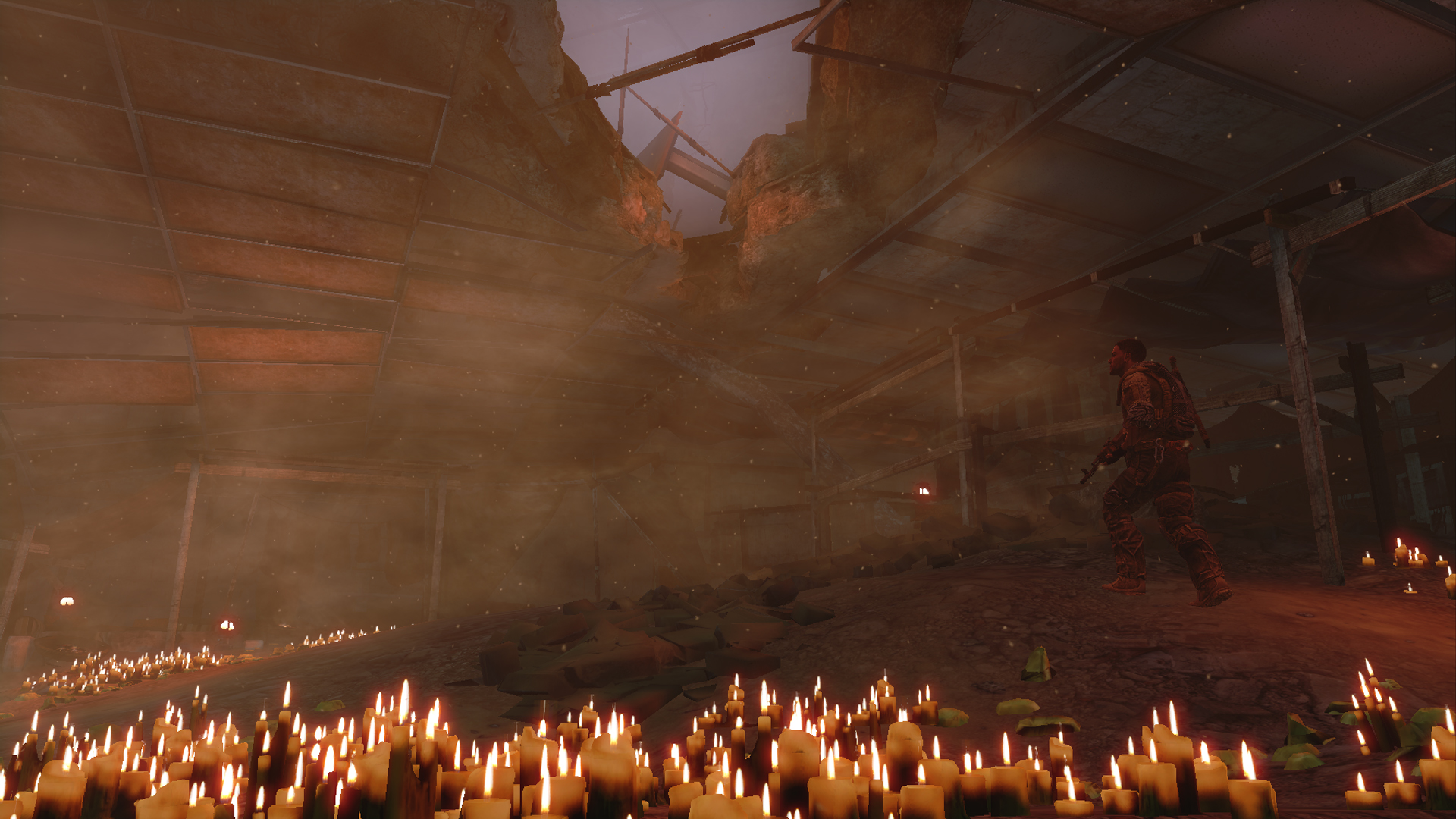
Nowhere in the The Line is this sense of darkness and depravity made more apparent than an event that occurs mid-way through the game. Not to put too fine a point on it (lest I give way to spoilers) but, at this point in the game, the player does a very terrible thing, an atrocity that, although done unknowingly, is easily one of the biggest sins anyone could ever commit. Spec Ops drives the point home strongly, leaving your mouth (and controller) on the floor and making you fell absolutely abysmal for. This event, however, plays a key role in the development of the player character (Walker) and spurs him on in a quest that yields tremendous consequences for both him and the survivors of Dubai. By the time the game comes to a close you find yourself on the edge of your seat in a way that only gamers who understand the meaning of the phrase “would you kindly” understand.
Though the game ends up being roughly eight or so hours in length Walker’s journey to end the madness that has engulfed the once prosperous city, you will definitely want to experience the story a second or even a third time thorough the witness all the endings and possibilities that occur. It’s not a story you could ever hope to share with your kids in the room but it’s an emotional tale that you’ll be talking about for some time to come.
Defining the Edge of Morality
As a traditionally-played third-person shooter, Spec Ops The Line shares very common, run-of-the-mill mechanics and gameplay systems seen in countless others. Like many other shooters it has a strong focus on cover-based firefights as well as AI compatriots who need your help far more often than they help you. You’ll engage most firefights the same way, the enemies offer little in terms of variety and the game has many staple elements such as turret sequences and moments when you are separated from your allies. Despite this, Spec Ops does have a few interesting elements to shake things up.
One of the most touted gameplay elements is the game’s use of sand. Rather than relegate it to being what you are trudging through for the majority of the game, sand can play a a role in combat. Windows and doors holding back torrents of sand can be destroyed to engulf your enemies in it and a well-placed grenade can create a screen of sand by which to stun them. Unfortunately the mechanic isn’t utilized nearly as often as it should be and the moments that they are usable end up being very transparent and seemingly only put there to remind you that it is a part of the game.
Another point of interest, and one that is far more interesting, comes in the form of player choice. At certain instances throughout the game players are given the option to make choices that directly affect both the storyline as well as your relationships with your AI companions. The choices can range in nature anywhere from having to save one person or the other to committing to an action that makes you question your humanity and with no clear good or bad option to be had. It’s a testament to a game when a choice makes you stop and ponder just how to handle a situation the way you would if you were actually there instead of your character and The Line pulls this off fantastically.
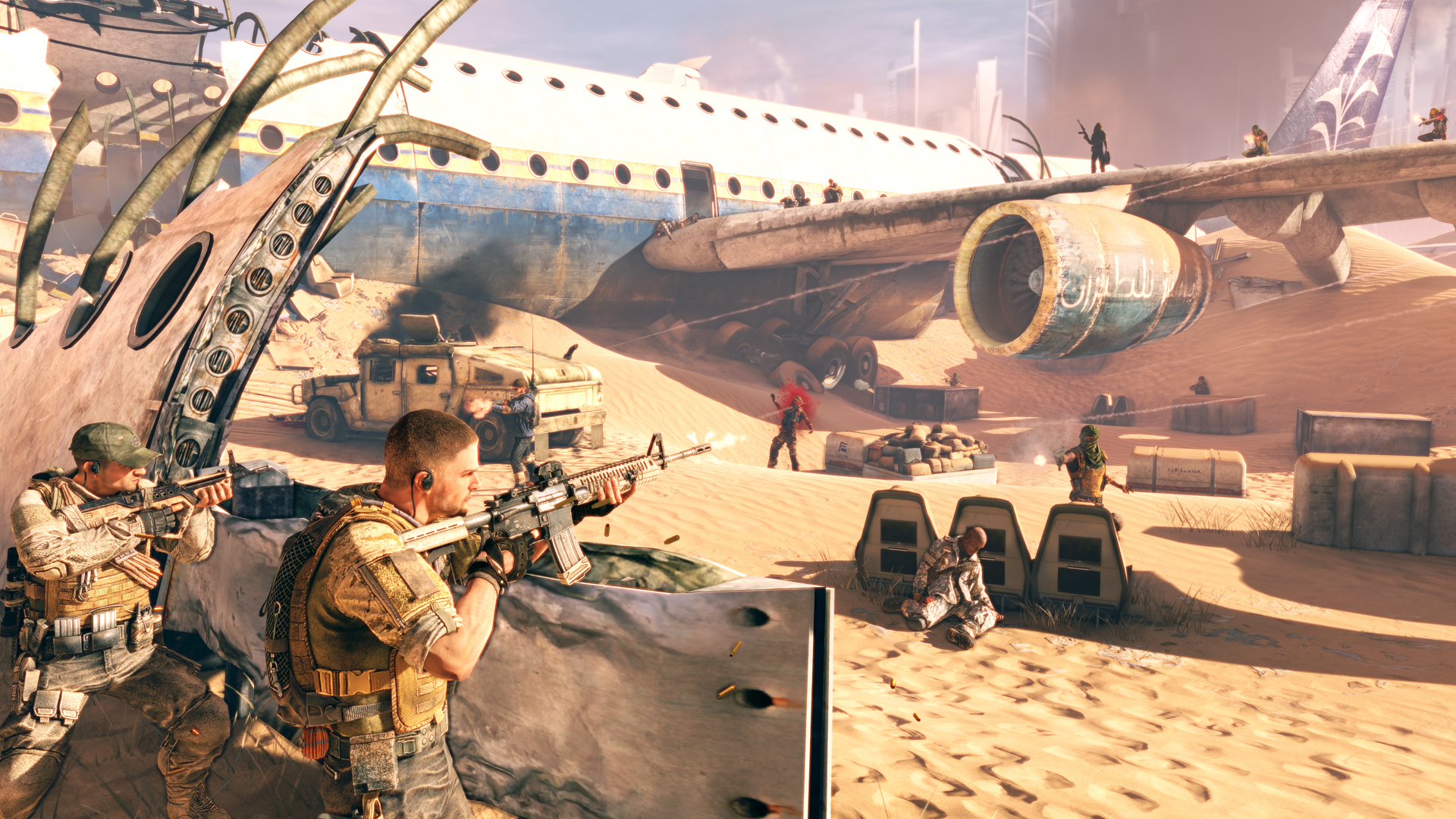
Probably one of the most interesting elements, and one that had this author intrigued about the game, is Walker’s descent into madness that occurs throughout Spec Ops. As Walker continues along in the story the choices he is forced to make begin to take a toll on his psyche, making him begin to lose touch with reality. One instance, for example, has Walker reflect on the game’s opening sequence as if he’s done it before, almost breaking the fourth wall for the player. Another has him taking on a tough enemy as a strobe light flashes off and on in a room full of mannequins, the enemy slowly advancing on him and with each flash suddenly appearing at another location. These sequences range from being chuckle-worthy to really unnerving, almost scaring the player as they desperately fight for their lives. It’s very well done and many of which come out of nowhere with little predictability.
Unfortunately, as is the case with most shooters these days, 2K made the judgment call to include a multiplayer component into the game. Handled by another developer (Darkside Game Studios), the effort is sadly wasted as the result is decidedly par for the course and ultimately unremarkable. Only the most curious should investigate the multiplayer component and, even then, you might as well go back to your favorite online shooter as there’s little here to be found and, of that, very lacking in an audience. It’s a shame too given that the singleplayer is remarkably enjoyable.
Staring Into the Abyss
Looking at Spec Ops The Line you’ll find a more par-for-the-course presentation before you. This is to be expected over six years into a console generation and while it doesn’t necessarily mean this is a bad thing but, at this point, it stands as a demonstration of the graphical limits of the Unreal 3 engine. Body animations are stiff at times, textures seem flat and the lighting scheme leaves a bit to be desired at times. Character facial animation only appears moderately worked on during cinematic sequences as, for the most part, your character doesn’t seem to emote at all throughout the course of the game. The game’s focus on sand doesn’t really stand up either as, since the use of sand is few and far between in firefights, seems to be a specifically-generated trigger event that lacks any sense of being organic for the experience. The presentation gets a few noteworthy bumps during Walker’s psychological events but, for the most part, isn’t a visual splendor to behold.
One thing you will find enjoyable about the game is the audio portion of the game’s presentation. The Line features an enjoyable soundtrack that’s surprisingly interspersed with licensed tracks such as Deep Purple’s “Hush” and the classic “Nowhere to Run to Baby” by Martha and the Vandellas. These shake up what would otherwise be just another firefight and turn them into rather enjoyable ones. Nolan North, probably the most prolific voice actor in video games other than Charles Martinet, takes on the role of Walker and while he does it using the same tone and pitch of voice as was utilized for Uncharted character Nathan Drake he does brings a very convincing take on a supremely stressed and mentally exhausted to the character.

Drawing the Line in the Sand
During the development of Spec Ops I was intrigued by this revival but, other than the initial trailer for the game, I couldn’t find myself getting excited by it. It remained elusive for the two years since it was initially announced, hidden behind wave after wave of other larger, more PR-driven titles like Saints Row, XCOM and The Darkness II. It is a shame that Spec Ops was relegated to being the kid in the back row rather than standing in the spotlight with these other great-looking games as it is probably one of the best Summer-release titles in the past few years.
Spec Ops The Line, though presented in the form of a traditional third-person shooter, takes the player on an adventure into the darkness that happens when civilization has ended and does so in a rather fantastic manner. Though the multiplayer is rather forgettable the game’s story has several ‘wow’ moments and a twist ending that leaves you stunned. It’s a solid modern shooter experience that brings to the table a great, memorable tale of survival and desperation. We need more stories like this in our games with guns that stand on par or higher than those that wield swords and bows and Yager delivered on this.
 Hooked Gamers,
Hooked Gamers,  Review
Review E3 2012: Dishonored Preview
 Wednesday, July 25, 2012 at 10:19AM
Wednesday, July 25, 2012 at 10:19AM 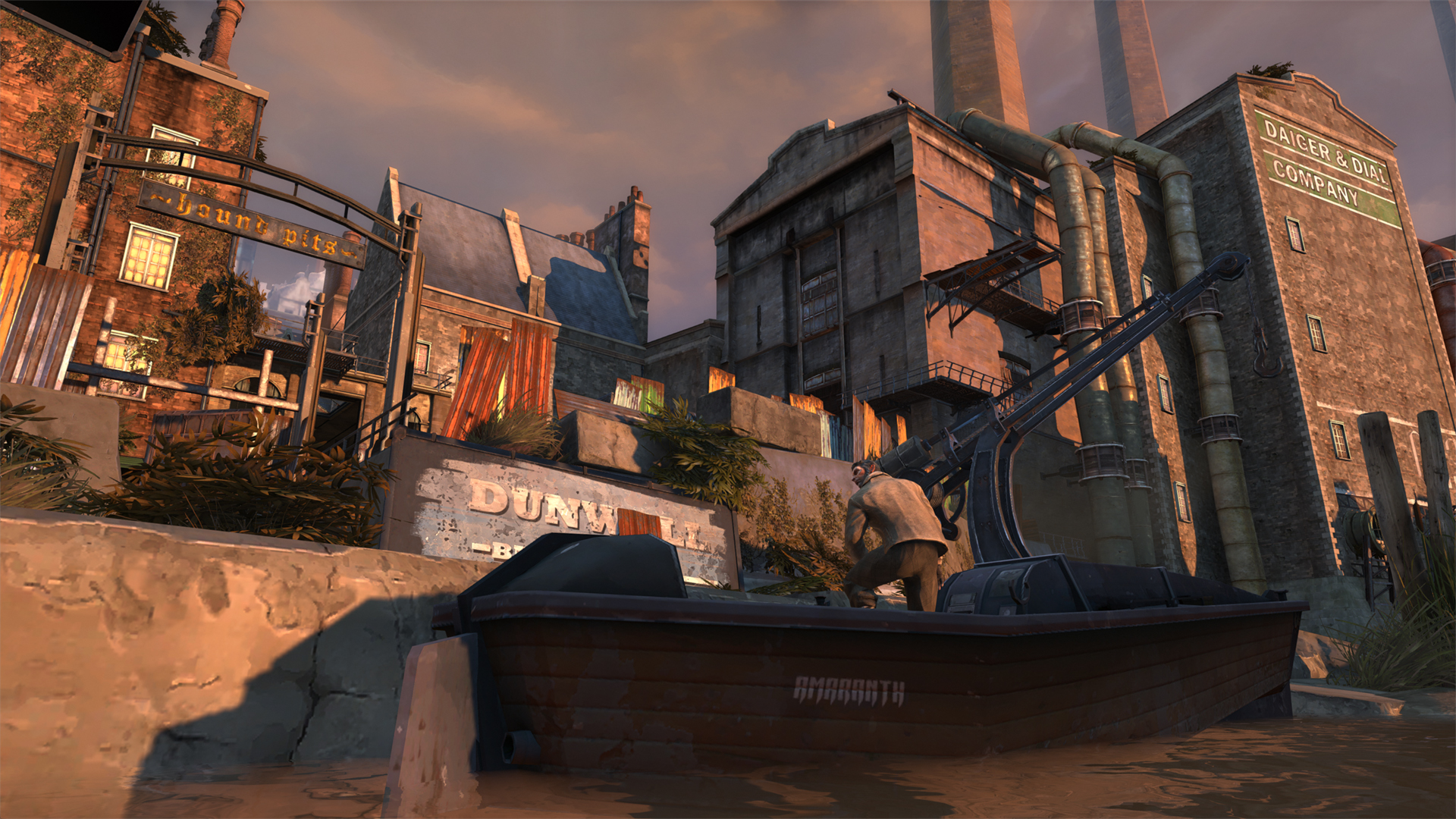
Last August I brought you our first preview of Dishonored, Arkane Studios’ first original title in over five years. You can read my extensive preview here but, for those who don’t want to, allow me to surmise my feelings as I left QuakeCon 2011: I was incredibly excited. Stealth- based games like Dishonored have been lacking in both quantity and stealth elements for several years now, the only significant title of the past three years coming to mind being Splinter Cell Conviction. For this year’s E3 Bethesda decided to properly unveil the game to the press and, judging by both the presentation and the live demo we got to play, the game is looking even more impressive than it did last year.
Click to read the full article
Feed Him to the Hungry Rats for Dinner
Sitting down in a room of thirty other gamers and journalists in the Bethesda booth, creative director Harvey Smith and introduced the demo by stating that we would see the same level played twice: once from a stealth-focused perspective and the other being a balls-to-the-wall, kill everyone approach. To get an appreciation for the stealthly nature of the game we were shown the most subtle approach first. Trust me when I say that what we saw delivered on what was spoken.
Today’s demo took place at the Golden Cat, a bathhouse in Dunwall that is also the site of a house of ill repute. You are tasked with eliminating the Pendleton brothers, twins that are part of the overall conspiracy that both murdered Dunwall’s Emperess and framed Corvo for the act. For the purposes of the demo the player was given the full array of Corvo Atano’s powers that will be featured when the game ships.
Starting out the level, Corvo descended to the streets (each level has multiple entry points, in this case we started out from a rooftop entrance) and nears the water’s edge adjacent to the Golden Cat. Using his possession ability, Corvo took control of a fish and swam into a broken pipe going into the building. He emerges from his pescadilliac possession in one of the women’s changing rooms. Barely sneaking past two entering whores, the player enters the main lobby of the Golden Cat with the objective of finding the Madame of the establishment in order to get a master key and thus move through the building unimpeded by pesky doors and the like. Sneaking upstairs, Corvo finds her on the other side of a door after peaking through a keyhole. Waiting for her to leave, the player follows her to a secluded room where he pickpockets her, the Madame never being the wiser.
Dishonored’s stealth gameplay, more than anything, seems strongly to be a cross between classic Metal Gear Solid and that of Splinter Cell Conviction, two titles that are widely different and yet, for this title, seem to match harmoniously. Enemies utilize a cone of vision that Corvo can detect using his Dark Vision power. If the player enters that cone of vision a circle appears on screen indicating how well they see you and from what direction you are seen. Once the indicator turns red the player has been fully recognized as an intruder and the NPC reacts accordingly. It’s an odd combination at first but, as demonstrated in Dishonored, works very well together.
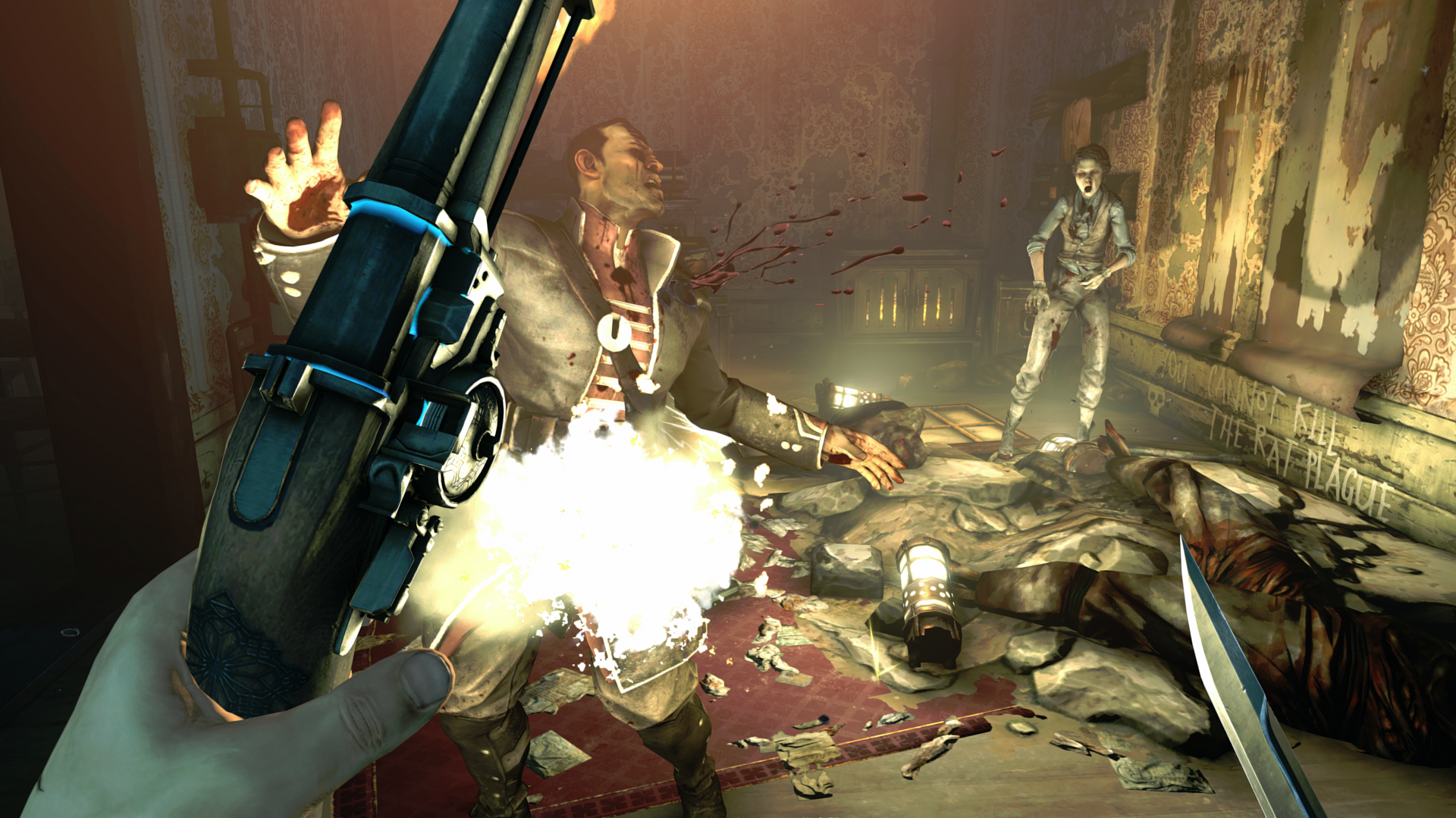
After returning to the lobby area Corvo overhears a conversation between a “relaxing” guard and his mistress which reveals the location of one of the Pendleton brothers: the basement sauna. Descending unnoticed, the player eventually locates the target in a steam room along with one of the mistresses. As if reading my mind that a blade would be too simple for the target, the player instead turns a valve controlling one of the steam pipes, scalding both of the victims to death.
With only one target left, Corvo ascends once again, sneaking past guards and wandering prostitutes alike. Corvo eventually locates his target in the penthouse room of the Golden Cat, the unsuspecting brother chatting it up with one of the ladies of the evening. Instead of barging in through the front door the player instead opts for the balcony. Climbing along the rooftop and utilizing the Blink ability which teleports the player a short distance, he reaches the balcony of the room with ease. Corvo then uses his possession ability once again to take control of the last remaining Pendleton, guiding him to the balcony itself. Withdrawing from the brother, the player selects Corvo’s Windblast power and, in a move seen countless times in Skyrim videos across Youtube, blasts the target over the edge and into the water below, eliciting a laugh from all in attendance. The last target eliminated, Smith ends the demo.
Restarting from the same position as when the stealth portion began, the player begins his more murderous approach. Corvo descends to the streets and attacks one of the guards outside the Golden Cat. The game’s melee-focused combat system is quite simplistic, acting similar to that of the attack, parry, counter system utilized in Skyrim and, more appropriately, Dark Messiah of Might and Magic. Corvo makes quick work of the guards and proceeds into the establishment.
It is here that a murderous onslaught began. Our demonstrator begins killing everyone in sight, guards and prostitutes alike, using all the tricks at his disposal. Corvo’s primary weapon in all of this is his blade which is dedicated to his right hand while his various tools of the trade as well as his magic powers are focused on the left hand. All manner of weapons, including his pistol are demonstrated, with items such the crossbow and the Plague of Rats power which gruesomely devours your unfortunate victims before your eyes. One particular weapon, a mine, deploys a band of razor wire that shreds enemies to pieces in a smile-inducing display of blood and muscle. No one is a match for the player but, again, since the demonstration gave you Corvo’s full arsenal of weapons and powers at their peak abilities, this is more than likely a scenario that most players won’t experience.
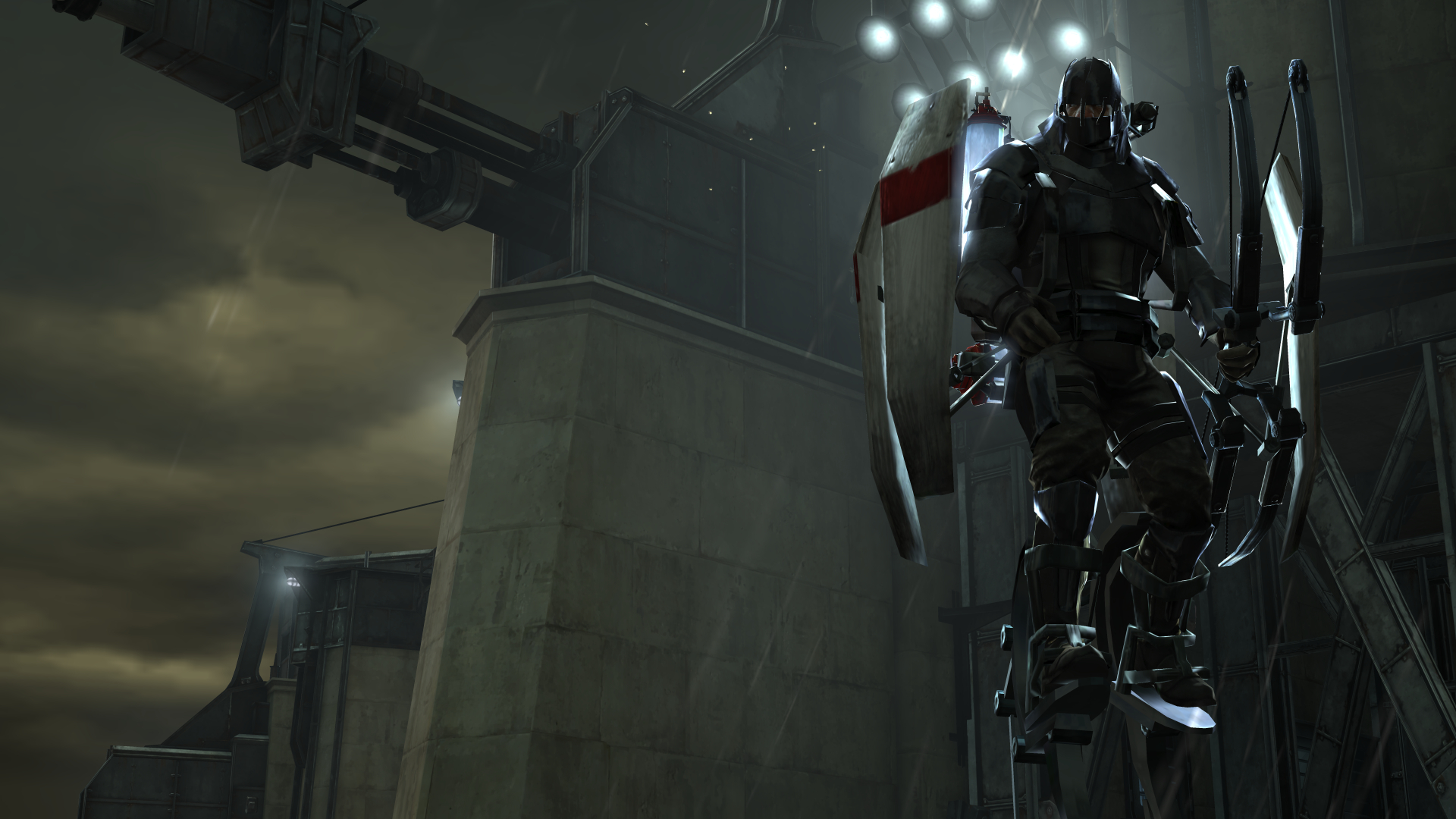
Weigh Hey, and Up She Rises
After the hands-off demo was shown to us, the press was allowed to actually experience the game hands-on, something I’ve been wanting to do ever since I first registered for E3 this year. The demo was different from the one we were shown, showing a far smaller slice of the game. Tasked with kidnapping the Imperial physician that conducted the autopsy of the Empress, I began the level once again on the rooftops. Knowing the target’s whereabouts I swiftly and silently used Corvo’s Blink power, bounding from rooftop to rooftop and bypassing all the patrolling guards on the street. I eventually arrived at the doctor’s rooftop laboratory and, sneaking up on him quietly, I knocked him out.
As I was about to leave I found a woman trapped in a cage just across the room. Feeling for her I filched the key from the doctor’s body and freed her. This action ties into the game’s world chaos system which, while not immediately having an impact on the game itself, will eventually culminate with world-altering results later on in the game. For now, it may have little impact but, for me as I tend to play very moral characters, it was a pleasing act of kindness in the cruel, cruel world that is Dunwall.
Taking the doctor’s body with me, I once again began to traverse the rooftops using the Blink ability. With my extraction point in sight I came across a group of citizens imprisoned along the roadside. I decided to help then and dropped the physician off right next to the exit before returning to the prisoners. On the wall adjacent to the cage I found the security controls and both deactivated the electrified cage and freed the citizens but not before being spotted by the patrolling guards. It was here that I was glad for once that no one was filming the game as, given I had only a handful of minutes of experience at the game already, I was doing a terrible job of fighting off the guards. I eventually was able to eliminate them all but not before a few of the citizens were killed in the process. I returned to the doctor’s body and took him to my contact, ending the demo.
I, however, wasn’t satisfied. With nary an appointment ahead of me I went began the demo again, this time determined to do better. I successfully knocked out the doctor once again, this time utilizing Corvo’s crossbow that was equipped with sleeping darts. I took his body out of the laboratory but stopped short of jumping across the rooftops. Below me, patrolling was a Tall Boy, a stilted soldier equipped with a explosive set of bow and arrows. The Tall Boy is easily one of the most imposing enemies in the game and is Dishonored’s take on the Strider from Half-Life 2. Selecting the Possession power I took control of the victim and marched down the street straight toward the prisoners as well as the pesky guards who gave me problems just a few moments ago. Using the Tall Boy’s weapons I quickly dispatched with the soldiers before exiting the victim. I quickly killed the Tall Boy using a sticky grenade so as to prevent experiencing what I had just done to the decimated soldiers at my feet. Freeing the prisoners, this time with nary a scratch on them, I retrieved the doctor and once again completed the demo.
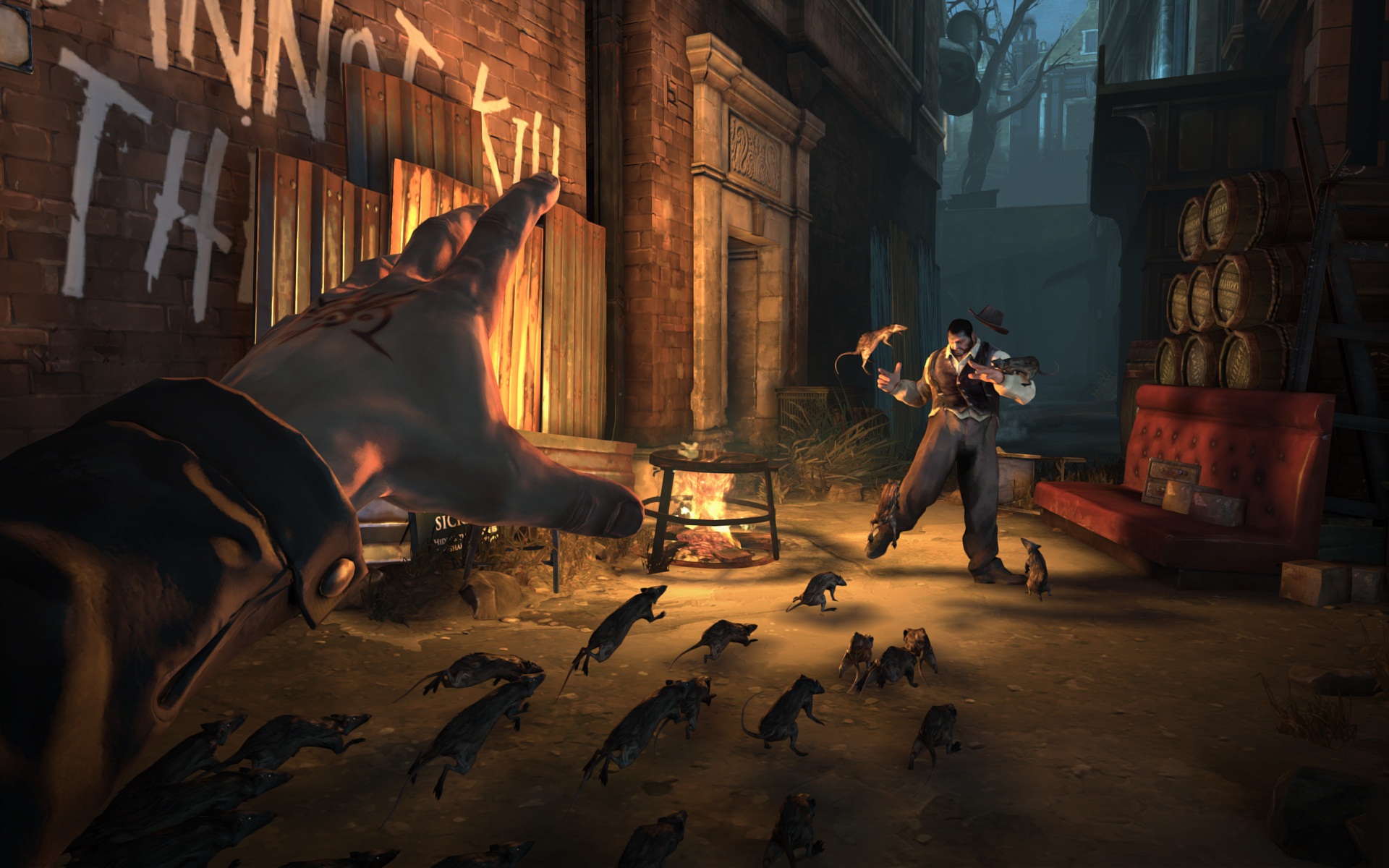
Early in the Morning
Dishonored was an exciting reveal for me last year and was a wonderful experience to have on the first full day of E3 2012. The stealth elements at this point seem very well done and the abilities at Corvo’s disposal make him a powerful opponent to the waves of guards and enemies of the game. Arkane brought us word shortly before E3 began that players can even do a pacifistic runthrough of the game, allowing you to complete Dishonored without actually killing anyone. Considering that I can recall a stealth action game allowing this since the last Metal Gear Solid title, my excitement is further heightened by the news.
With all the enticing titles being pushed into 2013 Arkane Studios’ latest will happily not be boarding the delay train and will instead arrive during the second week of October in North America in Europe. Stay tuned for our review.
 E3 2012,
E3 2012,  Hooked Gamers,
Hooked Gamers,  Preview
Preview E3 2012: Hitman Absolution Preview
 Monday, July 23, 2012 at 12:17PM
Monday, July 23, 2012 at 12:17PM 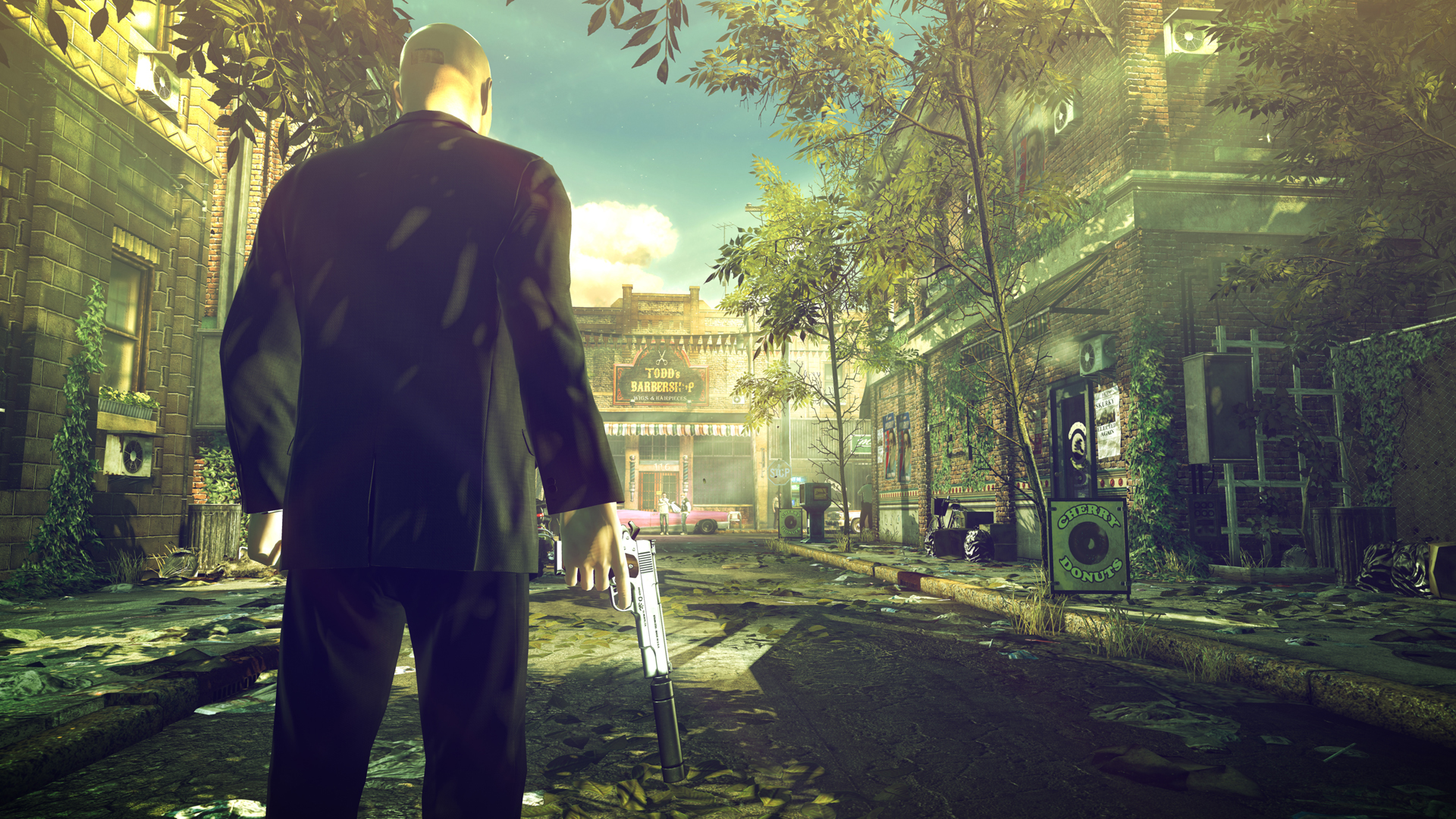
Last year, after almost half a decade of fans begging and screaming for a new entry into the Hitman franchise, developer IO Interactive finally relented to our demands, announcing the fifth title in the series dubbed Absolution. The news of a new Hitman title was wonderful to hear, especially in the wake of the less than stellar Kane and Lynch games that had been released between the 2005 hit Blood Money and then this title. What was demonstrated last year though was decidedly a title that, while intriguing, wasn’t a true Hitman experience. Instead of a sandbox, exploration-based stealth game what we saw was a strongly scripted, linear level that evoked the feel of Splinter Cell Conviction. It looked great, to be sure, but with no demonstration of traditional Hitman levels being present and only the promise of what we know and love being in the game, many of us were a bit put off.
Since E3 2011 publisher SquareEnix has been building a market campaign designed specifically to show just what is new and different with this latest title and it wasn’t until this year’s E3 that IO Interactive finally live up to their promise. And, despite all the shooty, naughty nun, murder-focused trailers we’ve been receiving over the past year, I’m proud to declare that every Hitman aficionado will have something to smile about come this November.
Click to read the full article
Real Men do it with Garrote Wire
E3’s hands-off demo took place much later in the game, sometime after Agent 47 has a falling out with the International Contracts Agency and is now on the run. This is made evident by the assassin having had his trademark barcode tattoo removed from the back of his head but more so than that he seems even more cautious than before. His crusade against his former employers at the ICA has brought him to the small South Dakotan town of Hope, a scene that feels just like any other small town you can drive through in the United States, albeit from a very outdated perspective. Agent 47’s targets are members of a greaser gang called the Cougars that holds control of Hope, the leader of which, Lenny, is about as dumb as a post save for his knowledge of a woman named Victoria whom 47 needs to find. Before you can interrogate him however several of his cronies need to be dealt with first, a task our demonstrator went right to.
Sneaking in through the backdoor of a small convenience store, one of the gang members is chatting up the female clerk as 47 hides behind cover. The target finally leaves, heading upstairs behind the counter, the giddy clerk all too oblivious of our favorite bald assassin. To distract her, 47 activates a radio on the counter behind him which draws the woman out, allowing him a slim window to sneak by and head upstairs. Spying the target looking out the window and talking on his cell, 47 sneaks up quietly and suffocates the man with his trademark piano wire. After hiding the body in a closet we head back down the stairs only to find that the clerk has returned to the counter and is blocking 47’s progress. Rather than kill the innocent woman was saw the assassin withdraw his trusty Sliver Baller pistol, complete with suppressor, and fire on the car just outside the front of the store. With the car alarm blaring and the clerk investigating the player easily slip out the door from whence he came, scott free.
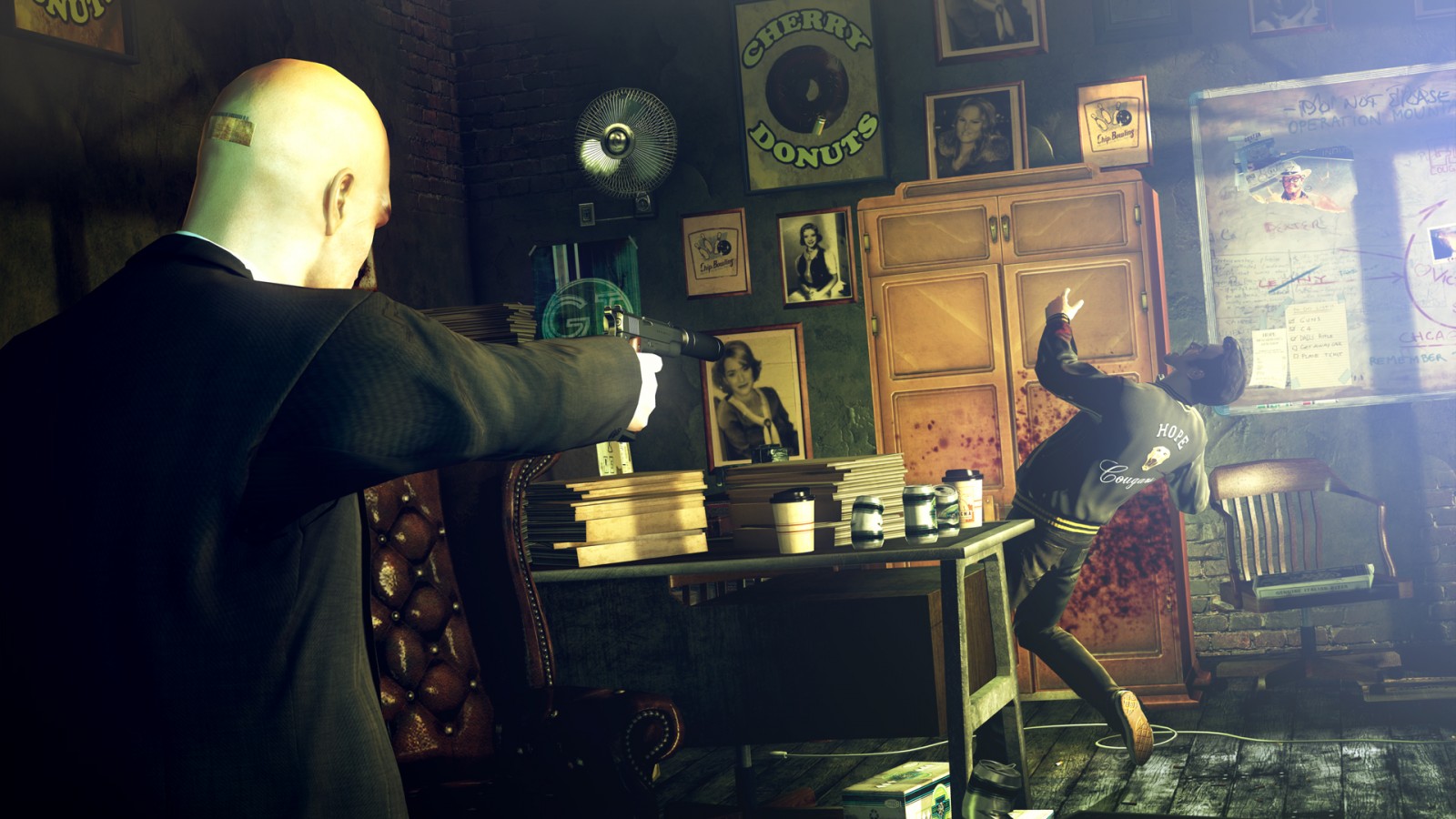
Much like its predecessor Blood Money, Hitman Absolution builds on the 2005 hit’s grading system but this time in a far more real-time focus. Rather than forcing the player to play through the entire level before knowing the results of their run a corner of the screen’s HUD indicates the player’s current skill status, grading the player based on kills, the method thereof, whether you were detected, etcetera. The IO Interactive rep for today’s demo clearly wants to show off the potential of what the new Glacier engine is capable of though so we weren’t in for a showing of what I Silent Assassin run would look like, especially as we started after the next target.
Across the street in an autoshop lies the next Cougar but unfortunately the place is covered with police officers. Sneaking behind some tires 47 enters the shop quietly, making his way upstairs toward the victim. After sneaking around for a bit though 47 is spotted by an officer. Before he can react though 47 shanks to man, his lifeless body hitting the ground with a loud thud. Our demonstrator decides to not hide the body and continues upstairs, eventually finding the Cougar member. 47’s next kill is a little more brutal, running the man straight through with a screwdriver. Finding some C4 and certain that the cops will eventually find their now deceased fellow officer our player decides to make the deaths an accident, dragging the target’s body outside behind a leaky gas pump. Sneaking back through the shop the player hides behind a stack of old tires as an officer is blocking his escape route. Equipping the C4, the player tosses it next to the gas pump, causing a loud enough thump to draw the cop’s attention away. Slipping by, the cop has no time to react as the player hits the trigger, causing a huge explosion that kills everyone in the vicinity. As more officers converge on the scene none of them take notice of the conspicuously well-dressed bald man walking away from the fiery scene. Two down, three to go.
The Streets of Hope
The next target is located behind the autoshop. Maneuvering behind an adjacent building, 47 slips behind a fence, entering a large yard. 47 is now trespassing and will be caught if seen so the player needs a disguise to walk around freely. Before he can do anything about that though a dog locked behind a fence begins barking at him. 47 quickly hides in an outhouse as a mechanic comes over to investigate. As soon as the mechanic gets within range and turns his back the player comes out, grabs the man and knocks him unconscious. 47 changes into the man’s outfit and, to avoid suspicion at their missing colleague, the player finds and tosses a bone into the dog’s pen, silencing it.
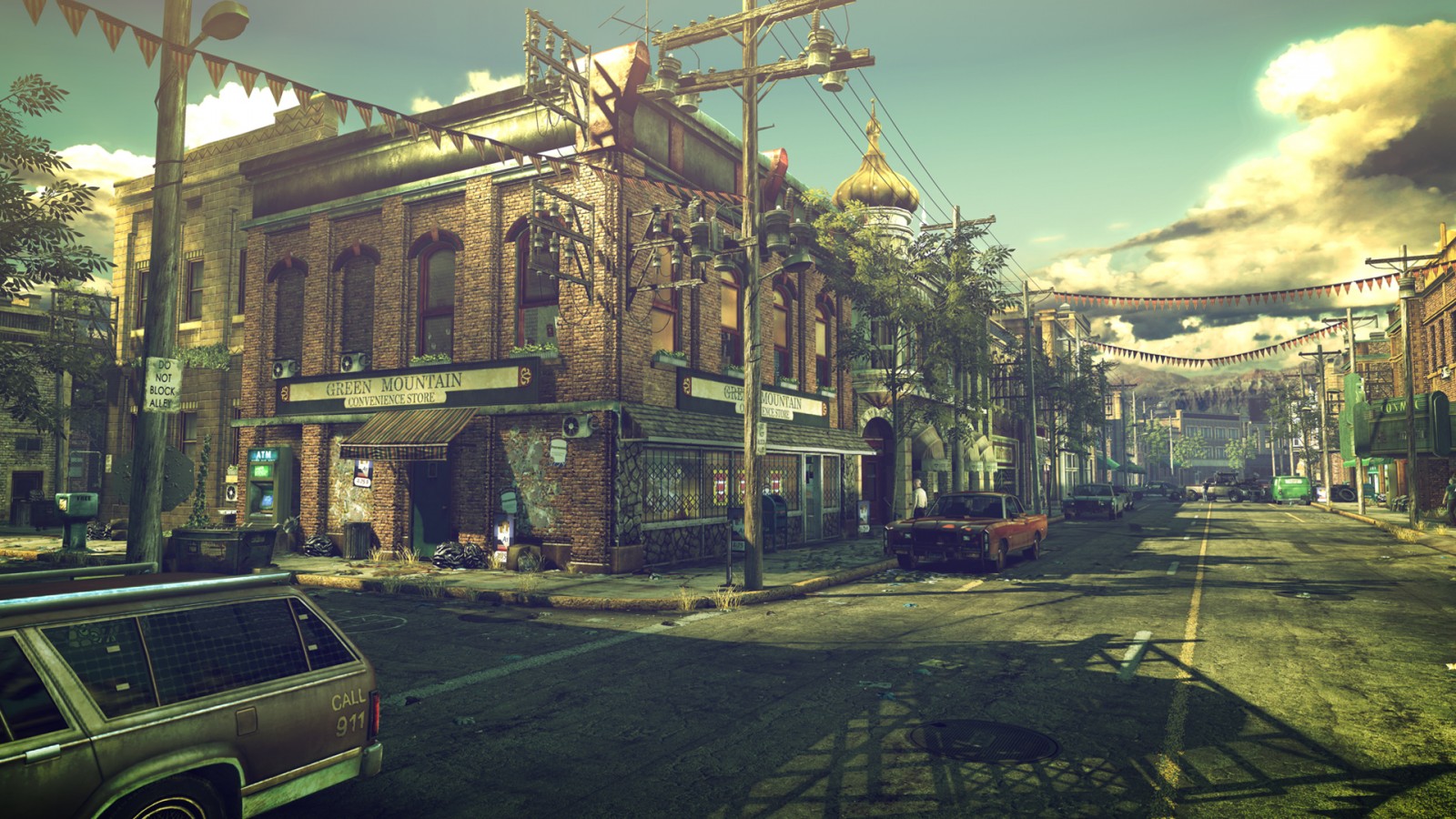
Now properly attired for this part of the level our demonstrator took us further into the year. Using 47’s new Instinct ability, the player averts the suspicion of a mechanic who didn’t recognize the strange, new bald man with a bloody bandage on the back of his head. Instinct also allows the player to see AI patrol patterns and NPC’s predicted movements in a certain area, albeit for only a short time. In the next section of the yard the player comes across a group of mechanics all sitting around along with the third target. The door is guarded by some well-armed thugs and it’s clear that no one dressed as a mechanic is going to get inside.
It is at this point that our demo player decides to show off another one of 47’s new abilities: Point Shooting. Using the same power guage as Instinct, Point Shooting allows you to mark targets in an area and, with the press of a button, execute them all with your chosen weapon. The ability is much like what John Marston utilizes in Red Dead Redemption, slowing down time to mark your targets and returning to real time as 47 begins dispensing death in the form of lead. The player marks all the targets in the vicinity and kills them all silently with 47’s silenced Silver Baller.
Only two targets remain as 47 activates his Instinct ability again and spies the fourth Cougar who is making his way downstairs, coming outside through the door that the thugs were guarding. With little time to react the player simply chooses to shoot the target in the head, preventing him from raising the alarm. With the four lieutenants dead all that remains of the Cougar gang is head honcho Lenny himself and, what do you know, judging from the Instinct vision it appears that he’s in a barber’s chair about to get a shave. It’s almost too good an opportunity to not take advantage of.
Climbing up the edge of a building, 47 slips through a window and surprises a barber, knocking him out cold. Once again the player trades disguises, going from a greasy mechanic to that of a clean cut hairdresser. Equipping the victim’s razor blade 47 descends the stairs into the barber shop proper where Lenny unwittingly awaits in his chair. As he comments on the new barber and his very “hands on” approach to giving a clean shave the music rises and the demo ends.
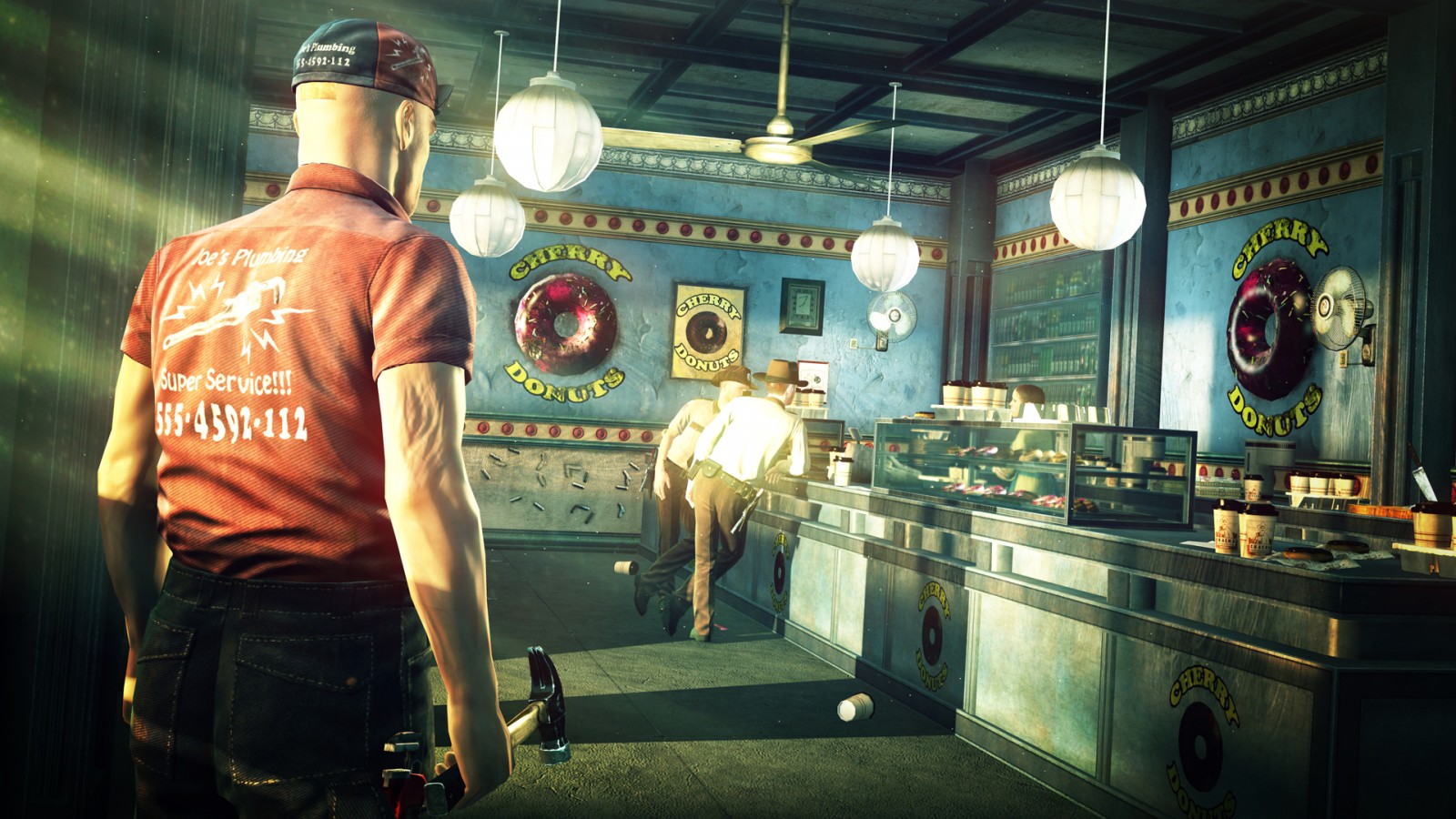
The World’s Deadliest Assassin
Ever since last year’s debut of Agent 47’s latest adventure fans have been skeptical as to whether Absolution would be a well and proper Hitman title. Despite having one of the most improper marketing campaigns in recent memory though IO Interactive is assembling a game that series fans will be proud to own when it arrives this November. With a mix of classic sandbox level design, new character abilities and story-driven transition levels, there is absolutely a lot to like and look forward to in the next Hitman.
 E3 2012,
E3 2012,  Hooked Gamers,
Hooked Gamers,  Preview
Preview 


Duties of the Royal Protector
Off the coast of the Pandyssian continent lie the Empire of the Isles, an industrialized nation spread across five islands with the capital being the city of Dunwall. A whaling town, an entire industry has arisen from the slaughter of monstrous whales from which their carcasses are used to create refined oil that powers the cities that dot the Isles. Recently though a plagued has broken out in Dunwall, eviscerating the lower tiers of society and slowly encroaching on the higher classes.
At the outset of the game, royal bodyguard Corvo Attano arrives back at Dunwall Tower from a month long diplomatic trip among the Isles in hope for a cure for the plague. As Corvo relates to Empress Kaldwin and her daughter Emily the bad news the trio is attacked by mystical assassins. Corvo is overwhelmed and he is forced to watch helplessly as the Empress is killed and Emily is kidnapped. Attano is framed for the crime and tossed into prison but is able to escape six months later. Arriving at a safehouse in a quarantined part of the city, Corvo meets with the Loyalist resistance members who aided in his escape. A conspiracy amongst the most powerful figures in Dunwall’s society arranged for the Empress to fall so that they could seize power and Attano is charged with the task of finding Emily and putting her on the throne.
The tale of Corvo Attano, former Royal Protector turned revolutionary assassin, is one told through the eyes of a silent protagonist but whose voice is given breath by player choice. Corvo’s quest isn’t so much one that forces the player to follow a strict narrative but is rather about offering the player a variety of options to complete objectives and returning to the Loyalist safehouse to receive the next mission. Within these missions, player choice is crucial to the continuing story, affecting the events to follow and even changing the world around to based on your actions. More on that in a moment.
It should be noted that Dishonored can be completed in six to eight hours should the player choose to focus solely on completing story objectives and leaving alone exploration and secondary quests. A much more fulfilling playthrough can be done in roughly ten hours and this can be extended even further if you attempt to do a no-kill or even a ghost runthrough. Beyond that Dishonored does not offer a multiplayer component so a replay of the story is the only option for players who want to get more bang for their buck. Sadly there is no ‘New Game Plus’ option available to players after completing the game but, given the length and breadth of the options available to the player, a second playthrough is highly recommended.
Merciful Pleas for an Unmerciful Crime
Corvo Attano certainly has his work cut out for him in Dishonored but, luckily for him, both his Loyalist compatriots and others make sure his is both skilled and well equipped for the task at hand. In your travels you will be able to procure and purchase a variety of ammunition for a pistol or, for those wanting a more quiet approach, a crossbow. Players can also upgrade the character’s weapons and equipment as well as Corvo himself, adding increased vitality or, most notably, enhanced agility that makes it far easier to get around the world.
Corvo isn’t just naturally talented and well equipped though: he’s also supernaturally powered. Early on in the game you are visited by an otherworldly character known as The Outsider who gifts you his mark and access to several supernatural powers both neutral and offensive in nature. Neutral abilities such as Dark Eye, which allows the players to see NPCs in the environment as well as their cone of vision, are worth far more than their offensive counterparts. Another, Blink, allows you to teleport short distances and is easily the best of them all. Those prone to exploration will swear by Blink and it will no doubt become one of your favorite powers. Let us not forsake the offensive abilities though as they are quite useful in times where stealth fails or the player prefers to slaughter all before him. Casting a Plague of Rats will result in your enemies being eaten alive, a most disturbing sight. Players can also use Windblast to send enemies flying in a manner not unlike Skyrim’s Unrelenting Force. It’s a fairly balanced supernatural package and one you will invest quite a bit of time upgrading.
Should you find that stealth is not your forte and a more action oriented experience is what you come to expect from games then Dishonored can certainly meet those needs. Combat in the game is a mixed affair of melee and semi-ranged combat, albeit more focused on the former rather than the latter. Melee played from a first-person perspective isn’t always particularly well done in this reviewer’s opinion but Arkane certainly got it right. You utilize your sword on the right hand to strike and parry at your enemies while utilizing your projectile weapons and supernatural abilities on the other. The targeting reticle for your off-hand projectile weapons is pretty generous and does not require center-screen aiming in order to properly mark an enemy. The AI of the game is programmed, in many ways, much like that of games like Assassin’s Creed and the Batman Arkham titles, a single melee attacker going after you while projectile weapon-wielding foes taking aim at any time they please. It definitely works, though in this reviewers opinion, a fight is not something to go looking for in Dishonored.
At the heart of the Dishonored experience though is the act of assassinating your targets and it is here that the game becomes the most exciting. Each one of these assassinations can be a puzzle in and of themselves, some aware of your presence while other not but all of them being a challenge. In many ways stalking your prey feels a lot like something pulled straight from Assassin’s Creed, leaving the player anxious before the kill and adrenaline-filled the moments after. Probably the most tantalizing aspect of these kills is the act of not committing to the kill at all as Arkane programmed in the option of neutralizing the target without the need for death. By completing certain objectives and side missions one does not need to kill their target, allowing you to take them out of the conspiracy’s equation but assigning them fates sometimes far worse than death. It’s this ability to do a no-kill run that had this reviewer focused squarely on punishing rather than murdering on his first playthrough and I highly encourage exploring this possibility in your experience, dear reader.
The stealth, combat and the choices you make regarding your targets all tie into one final, crucial element to Dishonored’s story. Known as the ‘Chaos system’, the city of Dunwall changes based on the player’s actions but this in no way should be considered a morality system. Arkane makes it well aware that this is in no way a story about a noble hero but rather one about revenge and the consequences thereof so instead the game grades you upon what you do in the world you find yourself in in a most indirect manner. Playing with a focus on killing or neutralizing your primary targets and aiding the various NPCs found in Dunwall will net Corvo a world wherein he can move around more safely and lands you a less dark ending. Should your killing gaze be less focused and you even bring death to innocents then Dunwall become far harsher as more guards will patrol the streets and more plague victims, derogatorily known as ‘Weepers’, will wonder them, spreading the infection. It’s very interesting to see how player actions can be affect Dunwall and its inhabitants, though it is much more subtle despite the polarizing results one can experience in a game like Bioshock.
Arkane has done a fantastic job at introducing us to a world so remarkably alien to ours even though it has its roots in our history nearly two centuries past. The city of Dunwall, modeled after 18th and 19th century English whaling towns, is decidedly less than your standard definition of steampunk and more of a fusion of Victorian-era design and sci-fi, raw metal oppression. The most apt comparison to be made is in looking to the wonderful Half-Life 2 wherein alien oppression walls and technology meets Eastern European architecture and Soviet-era design paradigms. This is more appropriate than one would think as Victor Antanov, the visual design director at Arkane, was also the art director for Valve’s 2004 wonder-hit. Many of the elements, from the vehicle design to the oppressive quarantine walls desperately trying to hold in the Rat Plague, make Dishonored’s art design feel like Half-Life 2 if it were set 200 years in the past. It’s quite wonderful and should rightly be celebrated.
It is fortunate that the art design is fantastic as it makes up for the one unfortunate part of Dishonored’s visual design: the graphics. The game runs on Unreal Engine 3, an engine which made its debut in 2006, has already been showing its age and this is made even clearer in Arkane’s title. While some texture work looks surprisingly good for such an old engine much of it appears muddled and bland. In addition, some of the animation work looks a bit rough at times and I would have hoped for the characters to emote a bit more. Those items being said however the game still looks great.
Whereas the visual design feels the pains of aging technology, the sound design is wonderful. Sounds pop in the right places, ambient noises draw the player into the environment and loud sounds like gunfire and explosions have a rather nice ‘oomph’ to them with it comes to base levels. The voice acting is particularly well done and draws on a surprisingly strong cast of actors. Up and coming actress Chloe Grace Moretz (who played Hit Girl from Kick Ass) does a very believable Emily while other actors such as Michael Madsen, Lena Hedley and even Susan Sarandon make the list, rounded out by veteran voice actors such as Anna Graves and April Stewart. The turnout for a game with such high quality talent isn’t unusual but for a unique, new intellectual property such as this, it is.
Arkane Studios’ Dishonored bears the distinction of being that one unique IP that arrives every fall and makes everybody take pause for a moment. Amidst a sea of sequels, overused game designs and rather unexciting ideas Dishonored stands out as one of the most unique titles of the year. While many comparisons can be made to titles of years gone by, this title pays tribute rather than is a detriment to excellent titles such as Bioshock, Assassin’s Creed, Half-Life 2 and yet stays true to the stealth genre with influences from Thief and The Chronicles of Riddick. Dishonored is a love letter to the stealth games and just what a title can be if you let a development team do what they want instead of forcing them to appeal to the masses.
At the end of this reviewer’s journey as Corvo Attano I can’t help but express excitement for Dishonored possible future and for what Arkane could be working on next. Let us hope that, one day, we get to explore the other Isles and perhaps the Pandyssian continent. For now though we have a fantastic stealth title and one worthy of placing on your shelf.